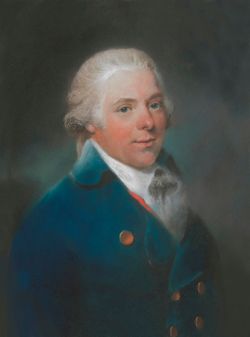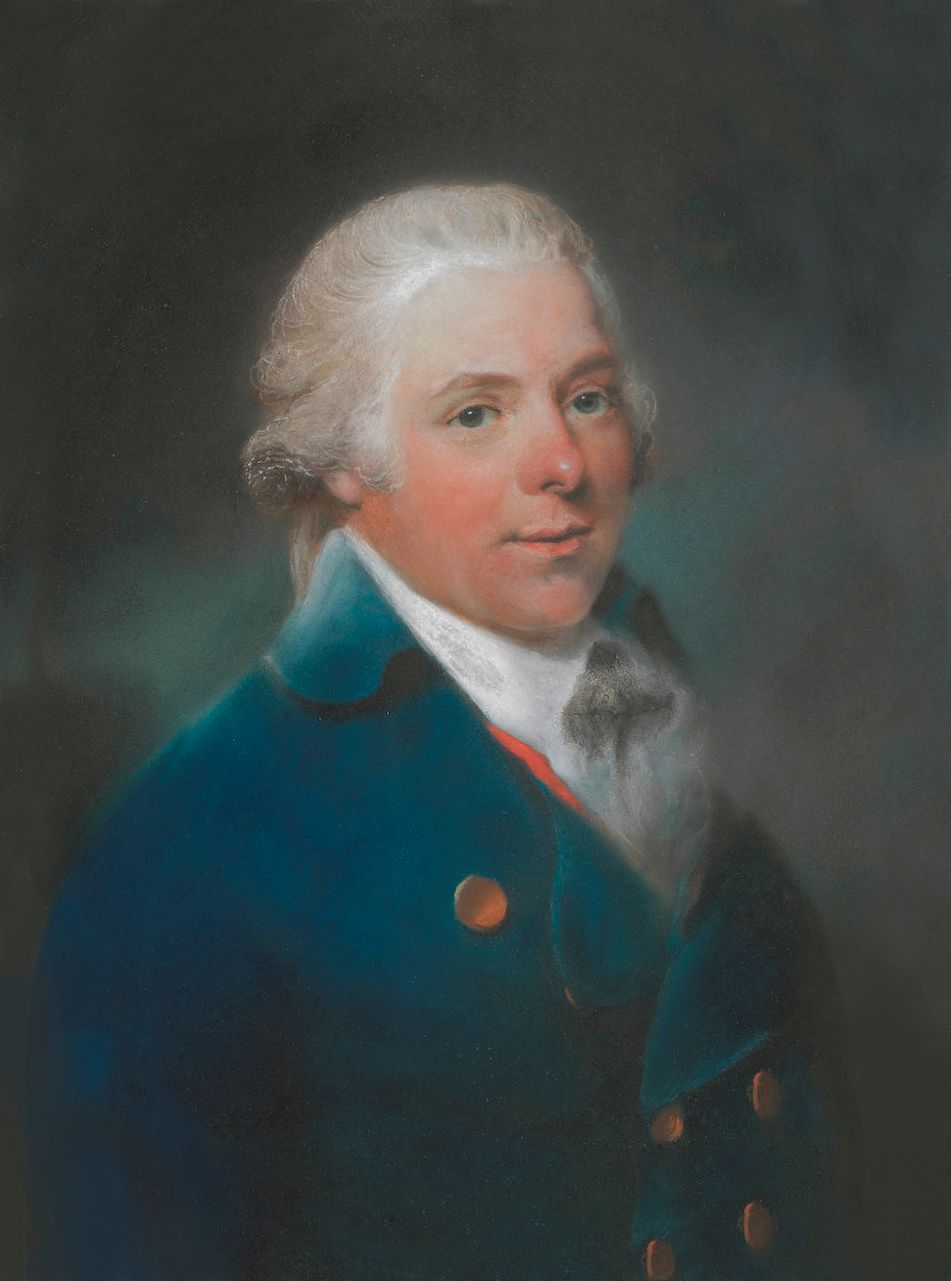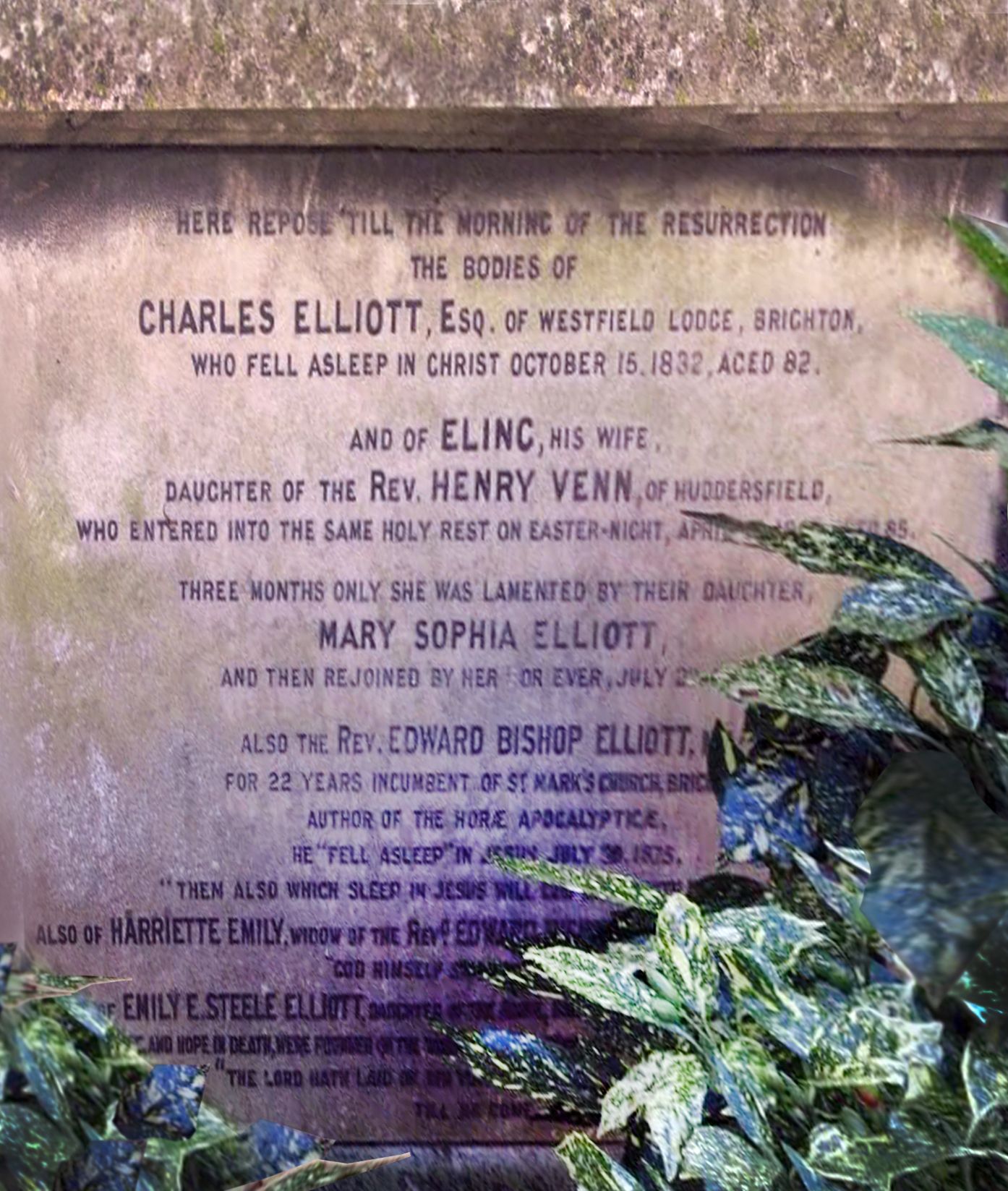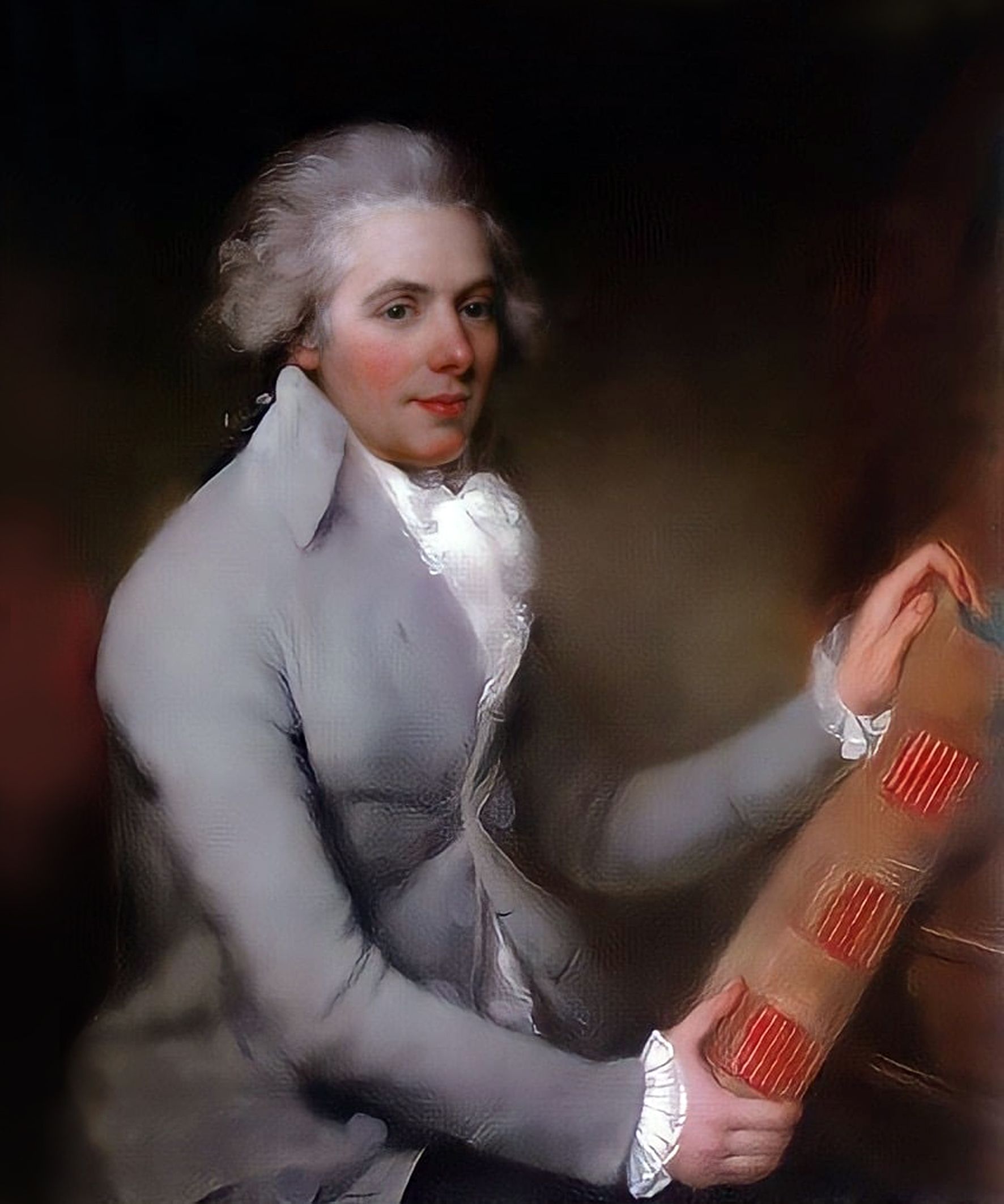He was married to Sarah Ann Sherman 1754-1784 and they had 5 children, Charles 1776, William Pearson Elliott 1780, Sarah Maria 1781 and John Sherman Elliott 1783 and Eliza 1782.
He then re-married on the 20 Dec 1785 after the death of his first wife in Yelling, to Eling Venn and they had 9 children.
Eliza b1786, Katharine Jane b1788, Charlotte b1789, Mary Sophia b1790, Rev Henry Venn Elliott 1792, Rev Edward Bishop Elliott b1793, Eleanor b1795, Joseph b1797, Basil Wood Elliott b1799.
Charles Elliott ~ London; cabinet maker and upholsterer
Charles Elliott was one of the chief London cabinetmaker of the late 18th century. He held royal appointments from 1783–c. 1810 and was succeeded as royal cabinetmaker and upholsterer by William Francis, his brother-in-law and partner. The firm continued in the royal service until the end of Victoria's reign. Elliott was a descendent of the Elliots of Liddesdale, famous in legends of the Scottish border. His father, outlawed for his part in the 1715 uprising, lived in Java where he worked for the Dutch East India Co. After his return to Britain he became the local Searches and Tidewater Officer in H M Customs at Burnham-on-Crouch in 1742. Charles was born there in 1752, one year before the death of his father. Heal, p. 53 notes ‘The Elliotts were an old cabinet-making family probably dating back to one William Elliott of Shenley, Herts., 1655– 1730. His brother John was working in London and died in 1729. The one who is best known was Charles Elliott…’.
In 1770 Elliott arrived in London ‘with a shilling in his pocket’ and was apprenticed to Paul Saunders, although since he served less than seven years, he must have begun his training elsewhere. In 1774 he became a partner in the firm of Davis and Elliott and was listed in Lowndes London Directory, 1775. The same year he married the daughter of Rev. Dr Sherman, Sarah Ann, at St George's, Hanover Sq., and by 1783 they had five children, all bapt. at the same church. During these years the business greatly prospered. In the mid-1770s carpets were supplied to Chatsworth; in 1775 he insured a house on Shepard St with the Sun Insurance Co. for £500. Also insured in 1775 were the firm's utensils, stock, goods, etc. for £1,100. In 1779 the firm's insurance was increased to £2,500, and Elliott, now successful, had his portrait painted by John Russell. In December 1781, George and Joseph Weston (alias Samuel Watson and William Johnson) were supplied with furniture, cutlery and plate for the Friars, Winchelsea, E. Sussex. The firm's insurance was further increased that year to £3,200.
Elliott became the sole proprietor of the firm in 1783 and is listed in various London directories from 1784–1808. In 1783 he received his first appointment as ‘Royal Upholsterer and Cabinetmaker’. From the beginning of his appointment he was the only royal furniture maker who was also employed as a general contractor and decorator, receiving a fixed salary of £157 10s 5d every quarter in addition to quarterly bills for furniture, mirrors, upholstery, carpets, etc. The contract work included ‘cleaning, renewing & fixing furniture’ at St James's, the House of Lords and Buckingham House, ‘washing, mending and making up of cushions, carpets, stools, sconces, curtains and tapestry’ for the Houses of Lords and of Commons, and also in 1791 the ‘use of a dozen Japan'd chairs and porterage to and from the Queen's house for the King's private apartment’. This contract work was continued by Elliott, Son & Francis as the firm was called after 1805. They charged, in 1810, the sum of £606 for re-upholstering the House of Commons, including ‘ripping out the whole of the leather cushions from the seats of the House entirely to pieces’. The House of Lords was also refurbished after the death of George III in 1820. Elliott and Francis received the commission under the supervision of Sir John Soane to carve and gild the canopy columns and made up the canopy and valances for the ‘a Large Corinthian Throne in the House for His Majesty’ as well as the upholstery for the throne itself, its footstool and table (illus. Roberts, Furniture History (1989), figs 11 and 12) now at Grimsthorpe Castle. The total bill for canopy, throne and 'a rosewood Table for the Throne with velvet cover trimmed with gold lace and fringe' was the considerable sum of £3,298. The throne canopy was to be protected when not in use by a crimson cloth lined with chamois leather. They also worked with John Russell, Vallance and Edwards to supply a throne, canopy, footstool and two high stools for the Robing Room at a total cost of £504 12s.
Descriptions of furniture in the Lord Chamberlain's accounts indicate the versatility of Elliott's work. In 1783 he completely furnished Swindley Lodge including ‘mahogany cabriole chairs covered with crimson silk damask’ and ‘festoon window curtains’ as well as a folding camp bedstead and ‘wainscott night stool and pan’. He provided ‘a very large mahogany sideboard table with 12 cellarets for 10 bottles; very fine wood and cross-banded and strong’, £17 10s, for the dining room at Newmarket Palace in 1784.
In 1787 a dispute arose between Elliott and the Prince of Wales over a £1,745 bill for various articles of upholstery and other furnishings. A committee of three arbitrated the matter and found in favour of Elliott. The accounts show that a substantial part of Elliott's work for the crown was upholstery — curtains, carpets, etc. Elliott, Son & Francis also provided both upholstery work and furniture for the Speaker's new Gothic Rooms: ‘two superb Gothic sofa tables on rich carved and socket claws, octagon molded pillars … partly gilt in burnished gold and picked in with polished black to look like ebony, the drawer fronts enriched with Gothic ornaments’ were provided in 1807.
In May 1784 Elliott's wife died, and a year and half later he married Eling Venn, whose father Rev. Henry Venn was one of the most important figures in the Evangelical movement in the Church of England. Elliott may have visited France or was involved in obtaining French furniture, as indicated in Venn correspondence, and the memoirs of Elliott's great-granddaughter, who described him as ‘the first importer of French furniture to London’. A 1784–86 cash book records a payment of £171 15s to Elliott although it is not known for whom he did the work. About this time William Francis, his brother-in-law, joined the firm. The insurance on the New Bond St premises was renewed for £3,200 in 1787. He had subscribed to the first edition of Sheraton's Drawing Book, as ‘upholsterer to his Majesty and Cabinetmaker to the Duke of York’ and acquired a ‘charming country villa at Paddington’ in 1792. He answered Pitt's appeal to the nation for finances with a loan in 1796; that year or the next the Elliotts moved to Clapham, retaining the Bond St premises.
Elliott was employed by William Tufnell of Langleys, Essex in 1797–98 to redecorate and provide furniture for several rooms. A surviving bill provides the only positive identification of Elliott's furniture. The bill is endorsed ‘part of the furniture of the drawing room; besides this the stoves in both rooms, chairs and tables in the green drawing room, windows and carpets in do., girandoles bronze, figures and two pier glasses’. Furniture which can be identified includes a satinwood Gothic back chair, a Pembroke table, a rectangular commode and an overmantle mirror. Also described in the bill is a pot cupboard, now in the bedroom, which is en suite with the rest of the furniture in that room, now attributed to Elliott. All the furniture at Langleys by Elliott is of fine quality. In addition to furniture the bill specifies ‘pumice stoning & sizeing the walls of the drawing room, 12 pieces of yellow satin ground paper, paste, hanging and panelled, 380 feet gilt molding’.
In 1798 no. 96 (103) New Bond St, also owned and usually rented out by Elliott, was occupied by Nelson after the Battle of St Vincent and ‘it was here that he dealt with the bill for his amputation’. At the formation of the Church Missionary Society in 1799 Elliott was elected to serve on the committee. He was a member of a host of other religious organizations as well as the Clapham Sect. In 1800 the premises in New Bond St were insured for only £1,000. Elliott and Co. appears in Sheraton's 1803 list of master cabinet makers. A minor commission was for Edward, Lord Lascelles in April 1801 for Harewood House, Hanover Sq., London. Elliott was paid £23. It is not clear exactly when Elliott retired but from 1805–19 the firm was called Elliott, Son, and Francis. In 1808 William Francis, the brother-in-law, was promoted to a partnership. From about 1819–27 the firm was known as Elliott & Francis and by 1821 the Elliotts were living mostly in Brighton. Elliott, Son & Francis is listed in various directories from 1806–27. In addition to work for the Royal Household a bill exists to the Hon. Mrs Leigh for a ‘circular japanned bamboo wash-hand stand’ for £2 10s in 1818. In 1826 Charles Elliott purchased the Chapel of St Mary in Brighton for £10,000 and presented the living to his son Henry who presumably left the firm about that time. From 1827 William Francis continued the business in his name alone and is listed in various London directories from 1827–39. In 1828 he assigned a lease to 17 Portland Pl. When he died in 1832 Elliott’s estate realized over half a million pounds, suggesting he had an astonishingly successful career. DEFM suggests he continued to work for the Royal Household until 1839-40, but this must surely be his successor. Davis & Elliot.
Source: DEFM; Kirkham, ‘The London Furniture Trade’, Furniture History (1988), pp. 63-4 & 92; Roberts, ’Royal Thrones 1760-1840’ Furniture History (1989).
He died in 1832 and was buried at St Andrews Old Churchyard, Hove.
He was married to Sarah Ann Sherman 1754-1784 and they had 5 children, Charles 1776, William Pearson Elliott 1780, Sarah Maria 1781 and John Sherman Elliott 1783 and Eliza 1782.
He then re-married on the 20 Dec 1785 after the death of his first wife in Yelling, to Eling Venn and they had 9 children.
Eliza b1786, Katharine Jane b1788, Charlotte b1789, Mary Sophia b1790, Rev Henry Venn Elliott 1792, Rev Edward Bishop Elliott b1793, Eleanor b1795, Joseph b1797, Basil Wood Elliott b1799.
Charles Elliott ~ London; cabinet maker and upholsterer
Charles Elliott was one of the chief London cabinetmaker of the late 18th century. He held royal appointments from 1783–c. 1810 and was succeeded as royal cabinetmaker and upholsterer by William Francis, his brother-in-law and partner. The firm continued in the royal service until the end of Victoria's reign. Elliott was a descendent of the Elliots of Liddesdale, famous in legends of the Scottish border. His father, outlawed for his part in the 1715 uprising, lived in Java where he worked for the Dutch East India Co. After his return to Britain he became the local Searches and Tidewater Officer in H M Customs at Burnham-on-Crouch in 1742. Charles was born there in 1752, one year before the death of his father. Heal, p. 53 notes ‘The Elliotts were an old cabinet-making family probably dating back to one William Elliott of Shenley, Herts., 1655– 1730. His brother John was working in London and died in 1729. The one who is best known was Charles Elliott…’.
In 1770 Elliott arrived in London ‘with a shilling in his pocket’ and was apprenticed to Paul Saunders, although since he served less than seven years, he must have begun his training elsewhere. In 1774 he became a partner in the firm of Davis and Elliott and was listed in Lowndes London Directory, 1775. The same year he married the daughter of Rev. Dr Sherman, Sarah Ann, at St George's, Hanover Sq., and by 1783 they had five children, all bapt. at the same church. During these years the business greatly prospered. In the mid-1770s carpets were supplied to Chatsworth; in 1775 he insured a house on Shepard St with the Sun Insurance Co. for £500. Also insured in 1775 were the firm's utensils, stock, goods, etc. for £1,100. In 1779 the firm's insurance was increased to £2,500, and Elliott, now successful, had his portrait painted by John Russell. In December 1781, George and Joseph Weston (alias Samuel Watson and William Johnson) were supplied with furniture, cutlery and plate for the Friars, Winchelsea, E. Sussex. The firm's insurance was further increased that year to £3,200.
Elliott became the sole proprietor of the firm in 1783 and is listed in various London directories from 1784–1808. In 1783 he received his first appointment as ‘Royal Upholsterer and Cabinetmaker’. From the beginning of his appointment he was the only royal furniture maker who was also employed as a general contractor and decorator, receiving a fixed salary of £157 10s 5d every quarter in addition to quarterly bills for furniture, mirrors, upholstery, carpets, etc. The contract work included ‘cleaning, renewing & fixing furniture’ at St James's, the House of Lords and Buckingham House, ‘washing, mending and making up of cushions, carpets, stools, sconces, curtains and tapestry’ for the Houses of Lords and of Commons, and also in 1791 the ‘use of a dozen Japan'd chairs and porterage to and from the Queen's house for the King's private apartment’. This contract work was continued by Elliott, Son & Francis as the firm was called after 1805. They charged, in 1810, the sum of £606 for re-upholstering the House of Commons, including ‘ripping out the whole of the leather cushions from the seats of the House entirely to pieces’. The House of Lords was also refurbished after the death of George III in 1820. Elliott and Francis received the commission under the supervision of Sir John Soane to carve and gild the canopy columns and made up the canopy and valances for the ‘a Large Corinthian Throne in the House for His Majesty’ as well as the upholstery for the throne itself, its footstool and table (illus. Roberts, Furniture History (1989), figs 11 and 12) now at Grimsthorpe Castle. The total bill for canopy, throne and 'a rosewood Table for the Throne with velvet cover trimmed with gold lace and fringe' was the considerable sum of £3,298. The throne canopy was to be protected when not in use by a crimson cloth lined with chamois leather. They also worked with John Russell, Vallance and Edwards to supply a throne, canopy, footstool and two high stools for the Robing Room at a total cost of £504 12s.
Descriptions of furniture in the Lord Chamberlain's accounts indicate the versatility of Elliott's work. In 1783 he completely furnished Swindley Lodge including ‘mahogany cabriole chairs covered with crimson silk damask’ and ‘festoon window curtains’ as well as a folding camp bedstead and ‘wainscott night stool and pan’. He provided ‘a very large mahogany sideboard table with 12 cellarets for 10 bottles; very fine wood and cross-banded and strong’, £17 10s, for the dining room at Newmarket Palace in 1784.
In 1787 a dispute arose between Elliott and the Prince of Wales over a £1,745 bill for various articles of upholstery and other furnishings. A committee of three arbitrated the matter and found in favour of Elliott. The accounts show that a substantial part of Elliott's work for the crown was upholstery — curtains, carpets, etc. Elliott, Son & Francis also provided both upholstery work and furniture for the Speaker's new Gothic Rooms: ‘two superb Gothic sofa tables on rich carved and socket claws, octagon molded pillars … partly gilt in burnished gold and picked in with polished black to look like ebony, the drawer fronts enriched with Gothic ornaments’ were provided in 1807.
In May 1784 Elliott's wife died, and a year and half later he married Eling Venn, whose father Rev. Henry Venn was one of the most important figures in the Evangelical movement in the Church of England. Elliott may have visited France or was involved in obtaining French furniture, as indicated in Venn correspondence, and the memoirs of Elliott's great-granddaughter, who described him as ‘the first importer of French furniture to London’. A 1784–86 cash book records a payment of £171 15s to Elliott although it is not known for whom he did the work. About this time William Francis, his brother-in-law, joined the firm. The insurance on the New Bond St premises was renewed for £3,200 in 1787. He had subscribed to the first edition of Sheraton's Drawing Book, as ‘upholsterer to his Majesty and Cabinetmaker to the Duke of York’ and acquired a ‘charming country villa at Paddington’ in 1792. He answered Pitt's appeal to the nation for finances with a loan in 1796; that year or the next the Elliotts moved to Clapham, retaining the Bond St premises.
Elliott was employed by William Tufnell of Langleys, Essex in 1797–98 to redecorate and provide furniture for several rooms. A surviving bill provides the only positive identification of Elliott's furniture. The bill is endorsed ‘part of the furniture of the drawing room; besides this the stoves in both rooms, chairs and tables in the green drawing room, windows and carpets in do., girandoles bronze, figures and two pier glasses’. Furniture which can be identified includes a satinwood Gothic back chair, a Pembroke table, a rectangular commode and an overmantle mirror. Also described in the bill is a pot cupboard, now in the bedroom, which is en suite with the rest of the furniture in that room, now attributed to Elliott. All the furniture at Langleys by Elliott is of fine quality. In addition to furniture the bill specifies ‘pumice stoning & sizeing the walls of the drawing room, 12 pieces of yellow satin ground paper, paste, hanging and panelled, 380 feet gilt molding’.
In 1798 no. 96 (103) New Bond St, also owned and usually rented out by Elliott, was occupied by Nelson after the Battle of St Vincent and ‘it was here that he dealt with the bill for his amputation’. At the formation of the Church Missionary Society in 1799 Elliott was elected to serve on the committee. He was a member of a host of other religious organizations as well as the Clapham Sect. In 1800 the premises in New Bond St were insured for only £1,000. Elliott and Co. appears in Sheraton's 1803 list of master cabinet makers. A minor commission was for Edward, Lord Lascelles in April 1801 for Harewood House, Hanover Sq., London. Elliott was paid £23. It is not clear exactly when Elliott retired but from 1805–19 the firm was called Elliott, Son, and Francis. In 1808 William Francis, the brother-in-law, was promoted to a partnership. From about 1819–27 the firm was known as Elliott & Francis and by 1821 the Elliotts were living mostly in Brighton. Elliott, Son & Francis is listed in various directories from 1806–27. In addition to work for the Royal Household a bill exists to the Hon. Mrs Leigh for a ‘circular japanned bamboo wash-hand stand’ for £2 10s in 1818. In 1826 Charles Elliott purchased the Chapel of St Mary in Brighton for £10,000 and presented the living to his son Henry who presumably left the firm about that time. From 1827 William Francis continued the business in his name alone and is listed in various London directories from 1827–39. In 1828 he assigned a lease to 17 Portland Pl. When he died in 1832 Elliott’s estate realized over half a million pounds, suggesting he had an astonishingly successful career. DEFM suggests he continued to work for the Royal Household until 1839-40, but this must surely be his successor. Davis & Elliot.
Source: DEFM; Kirkham, ‘The London Furniture Trade’, Furniture History (1988), pp. 63-4 & 92; Roberts, ’Royal Thrones 1760-1840’ Furniture History (1989).
He died in 1832 and was buried at St Andrews Old Churchyard, Hove.
Inscription
HERE REPOSE 'TILL THE MORNING OF RESURRECTION THE BODIES OF
CHARLES ELLIOTT, Esq. of Westfield Lodge, Brighton who fell asleep in Christ October 15th 1832, aged 82.
and of ELING his Wife. The Daughter of Rev. Henry Venn of Huddersfield, who entered into the same holy rest on Easter night, April 16 1843, aged 85
Three months only she was lamented by their Daughter, MARY SOPHIA ELLIOTT and then rejoined by her for ever July ?
Also the Rev. EDWARD BISHOP ELLIOTT, For 22 years incumbent of St. Marks Church, ? Author of the Horae Apocalypticae, he "fell asleep" in Jesus July 30 1875.
Them also which sleep in Jesus
Also of HARRIETTE EMILY, widow of the Rev. Edward Bishop Elliott, ?
Emily E. Steele Elliott, Daughter of the above?
Gravesite Details
Grave is difficult to photograph, shrubbery and the lettering has now begun to vanish and becoming hard to read (2020). This photo was taken from the Brighton & Hove Discoverer and manipulated in photoshop as was taken side on.
Family Members
-
Charles Elliott
1776–1856
-
![]()
John Sherman Elliott
1783–1854
-
![]()
Katherine Jane Elliott Brasier
1788–1846
-
![]()
Charlotte Elliott
1789–1871
-
![]()
Mary Sophia Elliott
1790–1843
-
![]()
Rev Henry Venn Elliott
1792–1865
-
![]()
Rev Edward Bishop Elliott
1793–1875
-
![]()
Eleanor Elliott Babington
1795–1884
-
Joseph Elliott
1797–1797
-
Basil Wood Elliott
1799–1814
Advertisement
Explore more
Sponsored by Ancestry
Advertisement












